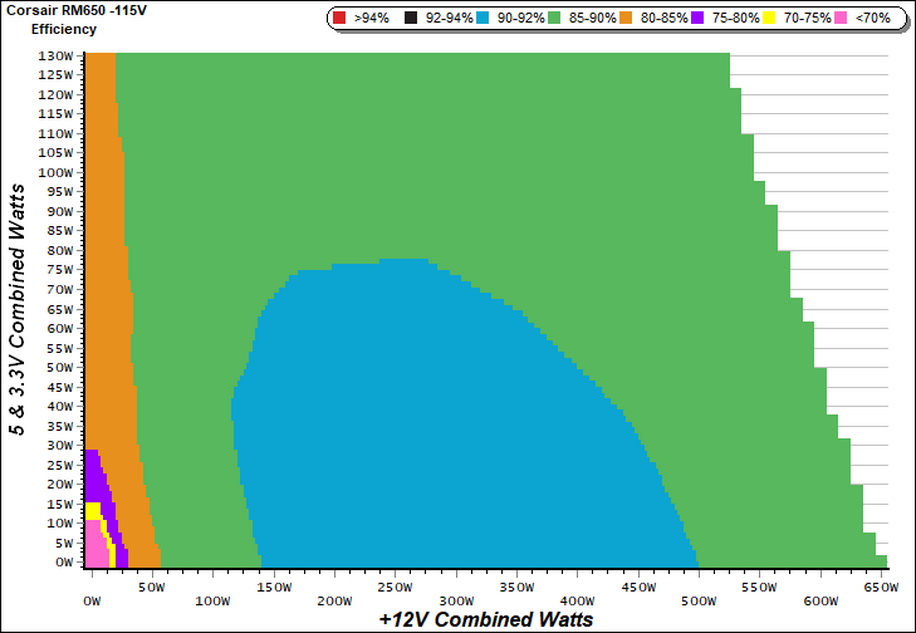Corsair RM650 Power Supply Review: Silent and Efficient
Why you can trust Tom's Hardware
Protection Features, DC Power Sequencing, Cross-Load Tests and Infrared Images
Protection Features
Check out our PSUs 101 article to learn more about PSU protection features.
| Protection Features | |
|---|---|
| OCP | 12V: 68.8A (127.41%), 12.021V 5V: 29.3A (146.5%), 5.023V 3.3V: 29.6A (148%), 3.283V 5VSB: 5.1A (170%), 4.920V |
| OPP | 841.3W (129.43%) |
| OTP | ✓ (157°C @ secondary side) |
| SCP | 12V: ✓ 5V: ✓ 3.3V: ✓ 5VSB: ✓ -12V: ✓ |
| PWR_OK | Proper Operation |
| NLO | ✓ |
| SIP | Surge: MOV Inrush: NTC Thermistor & Bypass Relay |
The OCP triggering points on the minor rails are super high, and the same goes for the 5VSB rail. In no case though, the load regulations is affected, and this is the case as well, for ripple suppression.
The Over Power Protection (OPP) is appropriately set, within 130% of the PSU's capacity. Finally, there is Over Temperature Protection, and the power ok signal is accurate (and longer than 16ms).
DC Power Sequencing
According to Intel’s most recent Power Supply Design Guide (revision 1.4), the +12V and 5V outputs must be equal to or greater than the 3.3V rail at all times. Unfortunately, Intel doesn't mention why it is so important to always keep the 3.3V rail's voltage lower than the levels of the other two outputs.



The 3.3V rail is the last to start, so its voltage is always lower than the other two.
Cross Load Tests
To generate the following charts, we set our loaders to auto mode through custom-made software before trying more than 25,000 possible load combinations with the +12V, 5V, and 3.3V rails. The deviations in each of the charts below are calculated by taking the nominal values of the rails (12V, 5V, and 3.3V) as point zero. The ambient temperature during testing was between 30 to 32 degrees Celsius (86 to 89.6 degrees Fahrenheit).
Load Regulation Charts
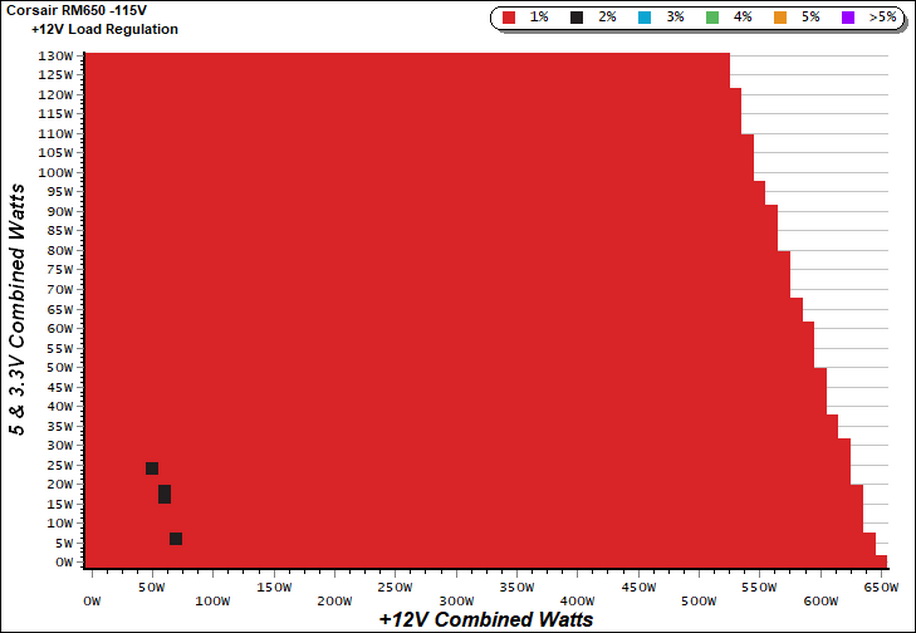

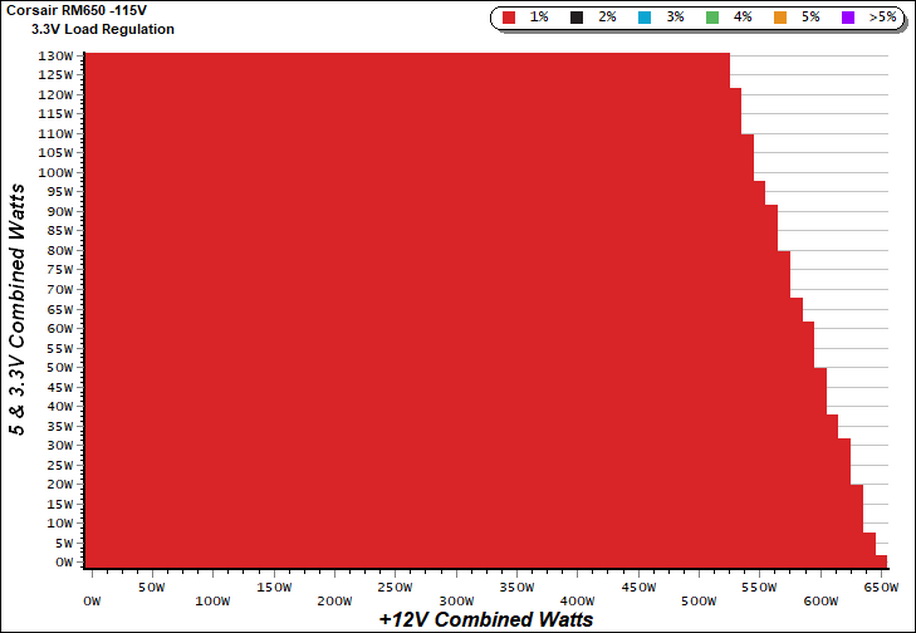
Efficiency Chart
The 90-92% efficiency region is quite large. It would be nice, to see even a small region, with higher than 92% efficiency.
Get Tom's Hardware's best news and in-depth reviews, straight to your inbox.
Ripple Charts
The lower the power supply's ripple, the more stable the system will be and less stress will also be applied to its components.




Infrared Images
We apply a half-load for 10 minutes with the PSU's top cover and cooling fan removed before taking photos with a modified FLIR E4 camera able to deliver an IR resolution of 320x240 (76,800 pixels).
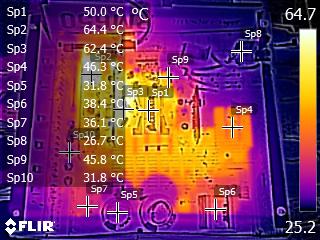
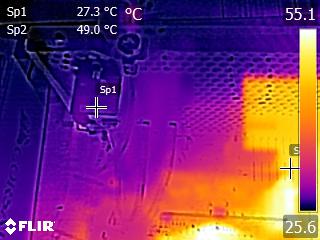

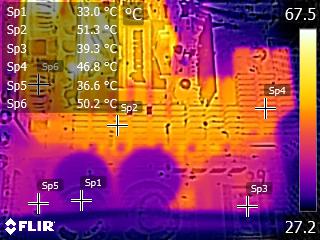
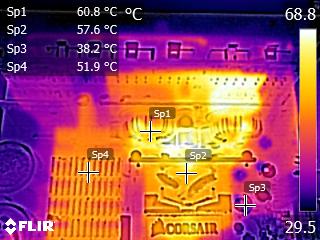
As we expected, the hottest parts are on the DC-DC converter's board, which we stressed enough with 10 Amperes of load on each of the 5V and 3.3V rails.
MORE: Best Power Supplies
MORE: How We Test Power Supplies
MORE: All Power Supply Content
Current page: Protection Features, DC Power Sequencing, Cross-Load Tests and Infrared Images
Prev Page Load Regulation, Hold-Up Time, Inrush Current, Efficiency and Noise Next Page Transient Response Tests, Ripple Measurements and EMC Pre-Compliance Testing
Aris Mpitziopoulos is a contributing editor at Tom's Hardware, covering PSUs.
-
jonnyguru Some background:Reply
The new Intel specification requires better efficiency at 2%-10% load and new timings (T1 and T3 to support modern standby mode). This was not easy/cheap to achieve, so Corsair couldn't just replace the current RMx in the market with a new, more expensive version without tangible differences. So the capacitors and fan was "down graded" (though Hong Hua is a fantastic fan manufacturer) to allow this "new version" of the RM to meet an acceptable price point.
Fun fact: Removing the caps from the cables saved A LOT of money. As you can see, it didn't have much impact. The caps in the cables in other models are only there to appease reviewers (like Aris) that compare ripple from one model to the next within mV of each other. -
Aris_Mp Replyjonnyguru said:Some background:
The new Intel specification requires better efficiency at 2%-10% load and new timings (T1 and T3 to support modern standby mode). This was not easy/cheap to achieve, so Corsair couldn't just replace the current RMx in the market with a new, more expensive version without tangible differences. So the capacitors and fan was "down graded" (though Hong Hua is a fantastic fan manufacturer) to allow this "new version" of the RM to meet an acceptable price point.
Fun fact: Removing the caps from the cables saved A LOT of money. As you can see, it didn't have much impact. The caps in the cables in other models are only there to appease reviewers (like Aris) that compare ripple from one model to the next within mV of each other.
Thank you Jon for the explanation on why the price had to drop so little compared to the RMx. Every time there is an ATX change, the production cost goes higher :(
the in-cable caps provide the wow factor he he. -
refillable ReplyAris_Mp said:Thank you Jon for the explanation on why the price had to drop so little compared to the RMx.
Wait, saw this review earlier but I realized that it has Su'scon caps. Su'scon is the "avoid" tier in your own capacitor tier list. Red flag? Makes me think that this series is even more useless than I previously thought especially that the RM650X can be bought for so cheap these days. -
jonnyguru Replyrefillable said:Wait, saw this review earlier but I realized that it has Su'scon caps. Su'scon is the "avoid" tier in your own capacitor tier list. Red flag? Makes me think that this series is even more useless than I previously thought especially that the RM650X can be bought for so cheap these days.
Aris has yet to visit a capacitor factory. -
refillable Reply
I don't get it, but I pretended I do :LOL:jonnyguru said:Aris has yet to visit a capacitor factory. -
jonnyguru Replyrefillable said:I don't get it, but I pretended I do :LOL:
Since moving from being a reviewer to someone working in the industry, I've learned that 75% of what is said in reviews, including a lot of the stuff I have said in reviews, is total B.S. -
refillable Replyjonnyguru said:Since moving from being a reviewer to someone working in the industry, I've learned that 75% of what is said in reviews, including a lot of the stuff I have said in reviews, is total B.S.
Thanks for clearing that up.
